17 Home Security Tips to Keep Your Home Safe: Pet Doors, Windows and Lights
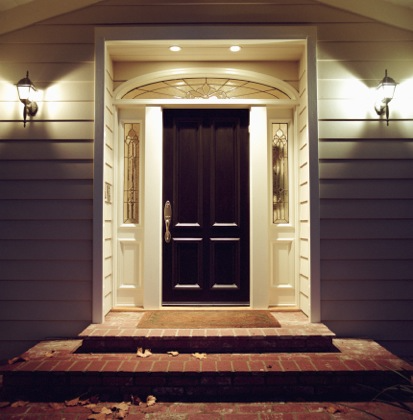
Home security is a basic necessity that everyone should put into practice to keep their home safe from intruders. There are several, simple things you can do to improve the safety and security of your home. In this article we will discuss doors, windows, lights, landscaping and additional security practices.
Doors
To start out, every home should have high quality exterior doors built of reinforced steel, fiberglass or solid hardwood. Some doors are hollow and have cardboard cores that will not prevent anyone from forcing entry into your home. If you are not sure what kind of door you have, give it a knock. If you hear a hollow sound, you need to invest in a better door. Don’t forget the back door, the side door or any other entry way. Every entrance should be evaluated for security. Sliding glass doors should be fitted with a wooden dowel, pipe or professional security hardware to keep them from being opened from the outside.

A solid door is key to home security.
Door Frames
Do not overlook the door frame. Door frames are what tend to give way when someone kicks a door in. Make sure your door frame is secured into the studs with several three inch long screws or nails on all sides. It would be a shame to miss something so simple to keep burglars from getting into your home.
To prevent forced entries, replace the original strike plate with a heavy duty, box strike plate with longer screws that will reach into the stud behind the door frame to make it harder to kick in the door.
Locks
Exterior doors should be equipped with Grade 1 or at least Grade 2 deadbolt locks with a minimum of one inch length on the deadbolt itself. If a burglar can see from the street that your home is not immediately easy to enter because you have a hefty door and two visible locks—one of them being a deadbolt—that can help dissuade them from targeting your home.
Glass located on or around the door should be at least 40 inches away from the inside locks and knobs. If there is glass within 40 inches of the door locks then you need to install a double cylinder deadbolt lock that requires a key to lock and unlock it from both sides.
A note on double cylinder locks: I have found some concern regarding double cylinder locks and fire safety. Essentially, in the event of a fire, double cylinder locks are bad because they can slow down, and in some instances, prevent escape from a burning building. You decide what is best for you and your family. Find an alternative or work out a system for escape should such a thing occur.

Dead bolt locks are a basic and essential part of home security.
Keys
Let’s talk about keys for a moment. If someone wanted to get into your house without trouble where would they look for a spare key? Under the door mat, or the flower pot perhaps? How about above the door jamb, or under that fake rock or really any conspicuous rock? Have I guessed where you hide your key yet? Let’s not hide spare keys outside homes anymore. It’s a poor idea and a great way to get robbed.
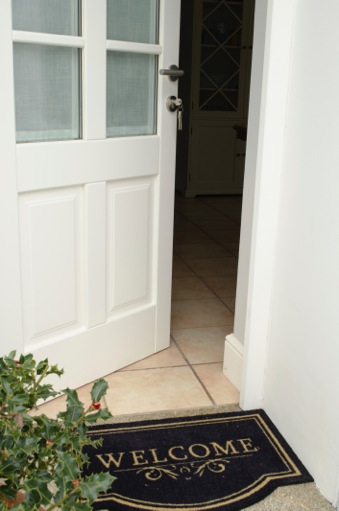
Hiding a key under a matt or rock outside the door is risky.
Peepholes
If you don’t already have one, install a wide angle peephole to prevent opening the door to an unwanted surprise. Consider installing a peephole at a lower level for children and wheelchair users so they don’t open the door to the wrong person. It should also be mentioned that you should always use the peephole on your door. Do not answer the door without knowing for certain who is on the other side.
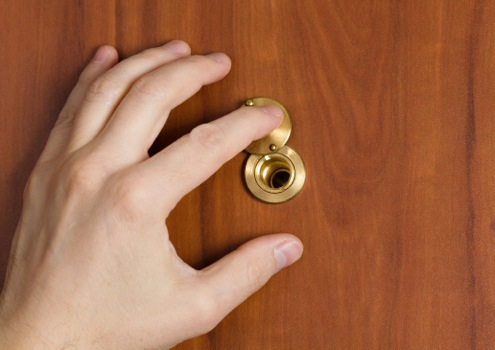
Peephole’s are a great home security feature to add to your door.
Hinges
Doors installed so that the hinges are on the inside of the house can prevent anyone from opening the door by removing the pins. There is a school of thought that says installing your entry doors so that they swing outward will prevent a successful blunt force entry. However, if your door does open outward take care to use hinges that have proper security features such as non-removable pins, security studs or shear resistant studs to prevent anyone from removing the pins and lifting the door off the hinges. Research what hinge features will be best for your needs.

Did you know you can buy hinges with security features?

House number
Make sure that your house number is in a logical, well lit and visible location on you house and is large enough to be seen easily from the street, preferably with a high contrasting background. In the event of any kind of emergency you want the emergency service personnel to be able to locate your home quickly.
Letter Slots
If you have a letter slot on your door take precautions to prevent anyone from attempting to enter your home by fishing your keys from the hall table with a stick. Get a letter box mounted to the door and don’t keep your keys close to the door.
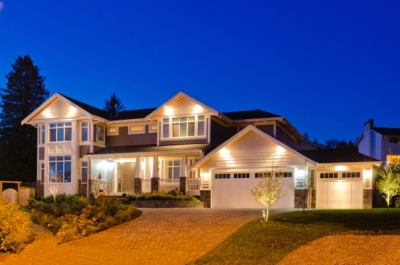
Pet Door
Personally, I am not a fan of pet doors for a couple of reasons. One reason being that I don’t like a pet having that kind of free range in my house. The other reason is because I don’t like that this is one more way for a thief to force his way into my house. I am sure in some instances a pet door is necessary. If this is the case for you, please take extra precautions to install the pet door 40 inches away from the door locks so no one can reach in and unlock the door. If 40-inch distance is not possible, install a double cylinder deadlock that must be locked and unlocked with a key from both sides. Keep the key well out of reach of the doggy door, or much like the letter box I mentioned in the previous post, someone could reach in with a wire hanger to get the key and let themselves in.

Ok, this dog looks like he would appreciate a larger door but, I would like to draw attention to fact that this pet door is not located on the actual door making it more difficult to use to break in.
If you have a large dog, I have to question whether a dog that large really needs to go in and out of the house whenever it wants. I assume a large dog like that has a doghouse and a fenced backyard to roam around in and needs a proper invitation to come in the house anyways. But, if a special door for this dog is really necessary, choose a pet door with security in mind that has a hefty security cover, like this one, so you can lock your house thoroughly at night and when you are away from home.
One more thought on pet door security. I am leery of installing an electronic pet door that can only be opened from the inside or when the sonic dog collar is in range. I believe in guard dogs, but I have also met a few would-be-guard-dogs that would have let anyone walk in the house and take the silver—it’s true, she was a Rottweiler and super dumb. If a dog like that doesn’t care that much she probably won’t mind if someone borrowed her collar and used her personal entrance either. If you must have an electronic doggy door, and your dog happens to be overly friendly, then take some thorough security landscaping design into consideration for your backyard. More on security landscaping in a future post.
Windows
Windows are yet another possible entrance into your abode. Such practices like closing and locking your windows at night and when you aren’t home are good places to start. Also, make sure your windows have adequate locks on them.

Make sure the windows on the first floor are lit properly.
One inexpensive method to prevent entry through a horizontal sliding window is to cut a wooden dowel long enough to fit between the sliding panel and the window frame to allow you to leave windows open just enough to allow a breeze, but keep would-be-intruders from opening the window further and climbing inside. Take precautions that the window is not able to open more than four to six inches with the dowel or lock pin in place, and that the distance from the opening to the lock—dowel or otherwise—or an adjacent door is long enough to prevent anyone from reaching in and unlocking anything.
There are window security products that you can find at the hardware store such as sliding window bar locks which can prevent anyone from opening the window further or prevent someone from lifting the window out of the track.
Because glass is easy enough to break, security film was developed which makes windows more difficult to break. Remember that you get what you pay for, so if this is a security feature you choose to install, read the reviews and choose a brand that is high quality. I had to share this next video. In this video, they demonstrate forced entries with and without security film. I am impressed how long it took to get through the window with security film.
Lights
A well-lit home is less attractive for someone to wreak havoc on because burglars don’t want to be seen. Go figure. Installing motion sensors that either turns the lights on or makes the lights go brighter when motion is detected, can startle and scare away anyone who is getting too close without an invitation.
According to AckermanSecurity.com, bright lights are not recommended for security because brighter lights cause darker shadows making it easier to hide. Ideal security lights will give you enough light to see without creating really dark shadows.
Lights should be placed over all entrances to the house; this includes the garage doors and first floor windows. Additional lights on the pathways is a nice touch visually and serves as additional security. Even if you can’t put lights everywhere you would like to, any light is better than no light. Choose the most effective spots for lighting and install them to deter troublemakers.
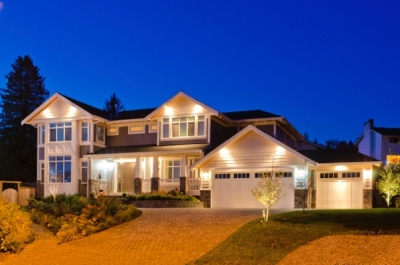
A well-lit house is a good practice for home security.
When you are going to be away from your home, place lights outside and inside the house on timers at different times of the evening and night to turn on and off and create the appearance that someone is home. Simply leaving a light on in the house while you are gone is bad for your electric bill and is not an effective way to make it appear that someone is home. Think about it, if you are home do you really leave the lights on all night?
There you have it! Pet doors, windows and lights. Next week we will continue this series with part 3 of home security tips to keep your home safe where we will discuss landscaping exterior buildings, security systems and guard dogs. For more tips and ideas, follow us on Facebook and Pinterest.
 Click to call
Click to call




